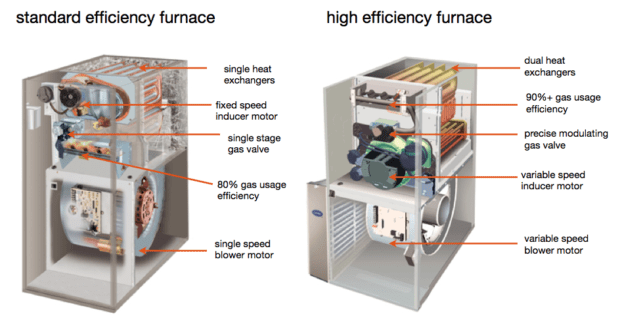Is it Time to Fix or Replace Furnace?
Whenever we get a call from an Indianapolis area homeowner to check their furnace, before we move to replace the furnace we always do everything possible to seek out a solution to repair and save their system. As we do during our Preventative Maintenance Program visits, we follow a thorough 19-point inspection of your heating system to see what issues you may be having and determine all viable solutions.
But the sad truth is that not all furnaces can be saved. Sometimes, it’s just time to say goodbye to your old heating solution and say hello to a new, much more efficient option.
Our friends at Carrier suggest checking three things before making a service call to Homesense. Having this information ahead of time might just help you prepare for whatever news your technicians shares.
1. Check the Date of Your Furnace.
Get acquainted with your furnace by checking its birthdate. Do you know the age of your furnace and when it was installed? The average lifespan of a furnace is 20 years, so if your unit is pushing that two-decade mark it may be close to the end of its lifecycle. Knowing the age can help you prepare for the inspection results. On most systems, inside the furnace cabinet, you will see a model and serial number.
Quick Tip: There is a nomenclature within the serial number that is specific to that brand system. For instance, in most Carrier furnaces the 1st/2nd number is the week and the 3rd/4th number is the year the furnace was manufactured. The quick way to determine your own nomenclature is to do a Google search for “x brand serial number nomenclature” and visit BuildingCenter.org that has most major manufacturers.
2. Check the AFUE Rating of Your Furnace.
Oh great, another acronym right? AFUE stands for Annual Fuel Utilization Efficiency, and it measures how efficiently your furnace converts the energy in its fuel to heat over the course of a typical year. More specifically, the Department of Energy defines AFUE as “the ratio of annual heat output of the furnace or boiler compared to the total annual fossil fuel energy consumed by a furnace or boiler. An AFUE of 90% means that 90% of the energy in the fuel becomes heat for the home and the other 10% escapes up the chimney and elsewhere.”
The Federal Trade Commission requires new furnaces to display an AFUE rating. If you can’t find yours, though, you should be able to call your furnace manufacturer. Having this information handy won’t save your furnace. But, here again, it will help you know how your unit compares to newer models and whether it’s best to repair or replace your furnace.
Quick Tip: If you have a metal pipe (flue) coming from your furnace, your AFUE is 80% or less. If you have a plastic 2 or 3 inch round PVC pipe coming from your furnace, it’s 90% or above.
3. Check Your Energy Bill.
With your AFUE rating in hand, dig out your energy bills. Knowing how much energy your current furnace is wasting—and, by the way, all new and old units waste some level of energy—you can easily calculate how much money you’re losing each month with your current unit. Furthermore, you can project how much money you could be saving with a newer, more efficient furnace. Using some of the Department of Energy calculators can then help you determine how soon you could recoup the cost of new furnace with resulting lower energy bills.
Quick Tip: If your gas bill in the winter is around $200/month—and with a conservative estimate that your furnace makes up 50% of that cost—we’d have a baseline of $100/month. If you are moving from a 70% efficiency system to a 95% efficiency system, we would expect a $25/month reduction.
With all this information, you’ll be able to better determine if it’s time to replace or repair your furnace. As always, we’ll be ready at 317-203-8149 to schedule a service call and answer your questions!
